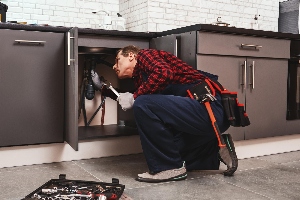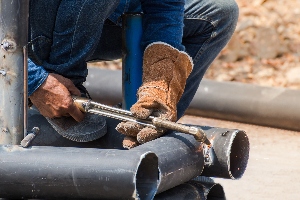When dealing with a clogged drain, you might consider a do-it-yourself approach to save on costs and time. However, before you begin, it's essential to understand that tackling drain cleaning comes with potential hazards. Protecting yourself and your plumbing requires adhering to specific safety measures to prevent accidents and ensure a successful outcome.
Prior to starting the cleaning process, equip yourself with the right tools and protective gear. Safety goggles, gloves, and appropriate clothing are necessary to shield against splash-back from chemicals or debris. It's also crucial to have a clear understanding of the plumbing system to avoid causing further damage.
Chemical drain cleaners offer a quick fix, but they contain harsh substances that can cause injury or damage to your pipes if not used correctly. If opting for these cleaners, ensure you follow the manufacturer’s instructions meticulously. For a safer alternative, physical tools such as plungers or drain snakes can be effective when operated with care. Whatever method you choose, it’s vital to approach the task with caution and informed precision.
Understanding Drain Systems
Before attempting any DIY drain cleaning, it's crucial for you to have a grasp of the different types of drains and common components.
Types of Drains
- Sink Drains: Found in kitchens and bathrooms, they typically include a strainer to catch debris.
- Floor Drains: Located in basements or garages, designed to handle overflow from sinks or toilets.
- Shower and Tub Drains: Contain a stopper or strainer to catch hair and soap buildup.
- Toilet Drains: Equipped with a trap that should always contain water to prevent sewer gases from entering the home.
Common Drain Components
- P-Trap: This curved pipe under the sink traps debris and prevents deep clogs in the plumbing system.
- Drain Trap: A similar concept to a P-trap, but for different drain types like floor drains.
- Vent Pipes: Essential for regulating air pressure and removing sewer gases.
- Clean-Outs: Allow for easy access to clear out blockages without removing the plumbing fixtures.
Safety Gear and Equipment
When undertaking DIY drain cleaning, prioritizing your safety is crucial. Ensure you have the right gear and equipment to protect yourself from potential hazards.
Protective Clothing
Wear long-sleeved shirts and long pants made of durable materials to shield your skin from splashes of harmful chemicals or debris. Opt for tight-fitting clothes to avoid them getting caught in equipment.
Safety Goggles
Select ANSI-approved safety goggles to safeguard your eyes. These should form a seal around your eyes to prevent any materials or liquids from entering.
Gloves
Use chemical-resistant gloves, such as those made from nitrile or PVC, which offer protection against caustic drain cleaners and provide a good grip when handling tools. Make sure they fit well and do not compromise dexterity.
Preparation and Precautions
Before undertaking DIY drain cleaning, safety should be your top priority. This involves setting up your workspace appropriately, diligently reading product labels, and ensuring proper ventilation is in place.
Workspace Setup
Ensure your workspace is clutter-free and well-lit. Keep children and pets away from the area to prevent accidents. Have the following items on hand:
- Bucket: To catch excess water or debris.
- Gloves: Preferably non-slip and chemical-resistant.
- Goggles: To protect your eyes from splashes.
- Old clothes: Protect your skin from exposure to harmful substances.
Reading Product Labels
Carefully read labels on drain cleaning products. Products should be chosen based on the specific type of clog and drain material. Note the following on the label:
- Ingredients: Identifies chemicals, which can inform you of potential risks.
- Instructions: Provides details on proper usage and amounts.
- Warnings: Outlines health hazards and first-aid information specific to the product.
Ventilation
Adequate ventilation is crucial when working with chemical drain cleaners. To ensure good ventilation:
- Open windows and doors: To allow fresh air circulation.
- Use fans: Can help direct airflow and dispel fumes.
- Take breaks: Step outside periodically to breathe in fresh air, especially if you feel lightheaded or dizzy.
Safe Use of Chemical Cleaners
When using chemical cleaners to clear your drains, it is crucial to select the right product, handle it with care, and dispose of any waste properly to ensure your safety and protect the environment.
Choosing Chemical Cleaners
- Read Labels Carefully: Look for cleaners suitable for your particular type of piping and the nature of the clog.
- Check Compatibility: Ensure that the chemical cleaner you choose is safe for use with septic systems if applicable.
Chemical Handling
- Wear Protective Gear: Always use gloves and goggles to prevent burns or irritation caused by accidental splashes.
- Avoid Mixing Chemicals: Never mix different cleaners, as this can cause dangerous reactions.
Disposal of Chemicals
- Follow Local Regulations: Dispose of unused chemicals or containers as per your local waste management guidelines.
- Never Reuse Containers: Do not repurpose containers that held chemicals, as residue can contaminate other substances.
Mechanical Cleaning Methods
Mechanical cleaning methods involve physical tools to remove blockages. These tools are focused on dislodging and extracting clogs without the use of chemicals.
Plungers and Augers
Plungers are a common tool for clearing minor blockages. The cup plunger is best for sinks and tubs, while the flange plunger is designed for toilets.
- Cup Plunger: For flat surfaces; create a seal, push down, and pull up forcefully.
- Flange Plunger: Has an extended rubber lip; ensures a good seal in the toilet bowl.
Augers, also known as plumber's snakes, can reach deeper clogs that plungers can't.
- Closet Auger: A specific type of auger made to navigate toilet pipes.
Drain Snake Operation
Operate a drain snake by inserting its coil into the affected drain.
Instructions:
- Insert the coil into the drain until you feel resistance.
- Turn the handle clockwise to catch the clog.
- Pull the snake out slowly to remove the obstruction.
Remember to wear gloves and goggles for protection.
Best Practices for Preventative Maintenance
Regular maintenance is key to preventing clogs and ensuring your drainage system remains in good working condition. Here are several steps you can take:
- Weekly Flushes: Heat a large pot of water to a rolling boil. Carefully pour it down your drains to help dissolve fats, oils, and grease buildup.
- Strainers and Filters: Install sink strainers and tub filters to catch food particles, hair, and other debris. Clean these regularly to prevent blockages.
- Baking Soda and Vinegar:
some text- Once a month, sprinkle 1/2 cup of baking soda into each drain.
- Follow with 1/2 cup of white vinegar.
- Allow the mixture to fizz for 15 minutes, then flush with hot water.
- Enzymatic Cleaners: Utilize enzymatic drain cleaners monthly. They break down organic matter without damaging pipes.
- Avoid Chemicals: Steer clear of caustic chemical cleaners as they can erode pipes and harm the environment.
- Be Mindful of Waste: Never dispose of coffee grounds, cooking grease, or non-dissolvable items in the drain. Dispose of these in the trash.
- Professional Inspection: Schedule a yearly check-up with a professional plumber to inspect for hidden issues and clean hard-to-reach areas.
By following these steps, you can keep your drains clear and minimize the need for emergency repairs.
Emergency Procedures
In tackling DIY drain cleaning, you should be prepared to handle potential emergencies. Knowing the right procedures for electrical safety and water overflow management is essential for preventing harm and property damage.
Electrical Safety
- Shut Off Power: If there is any risk of water coming into contact with electrical outlets or appliances, immediately turn off the electricity at your breaker box.
- Use Ground-Fault Circuit Interrupters (GFCIs): Always plug any electrical equipment you are using into GFCIs to reduce the risk of shock.
Water Overflow Management
- Stop Water Flow: Quickly turn off the source of water to prevent further overflow.
- Clear Affected Area: Relocate any electrical devices and clear the space of valuables and hazardous materials.












